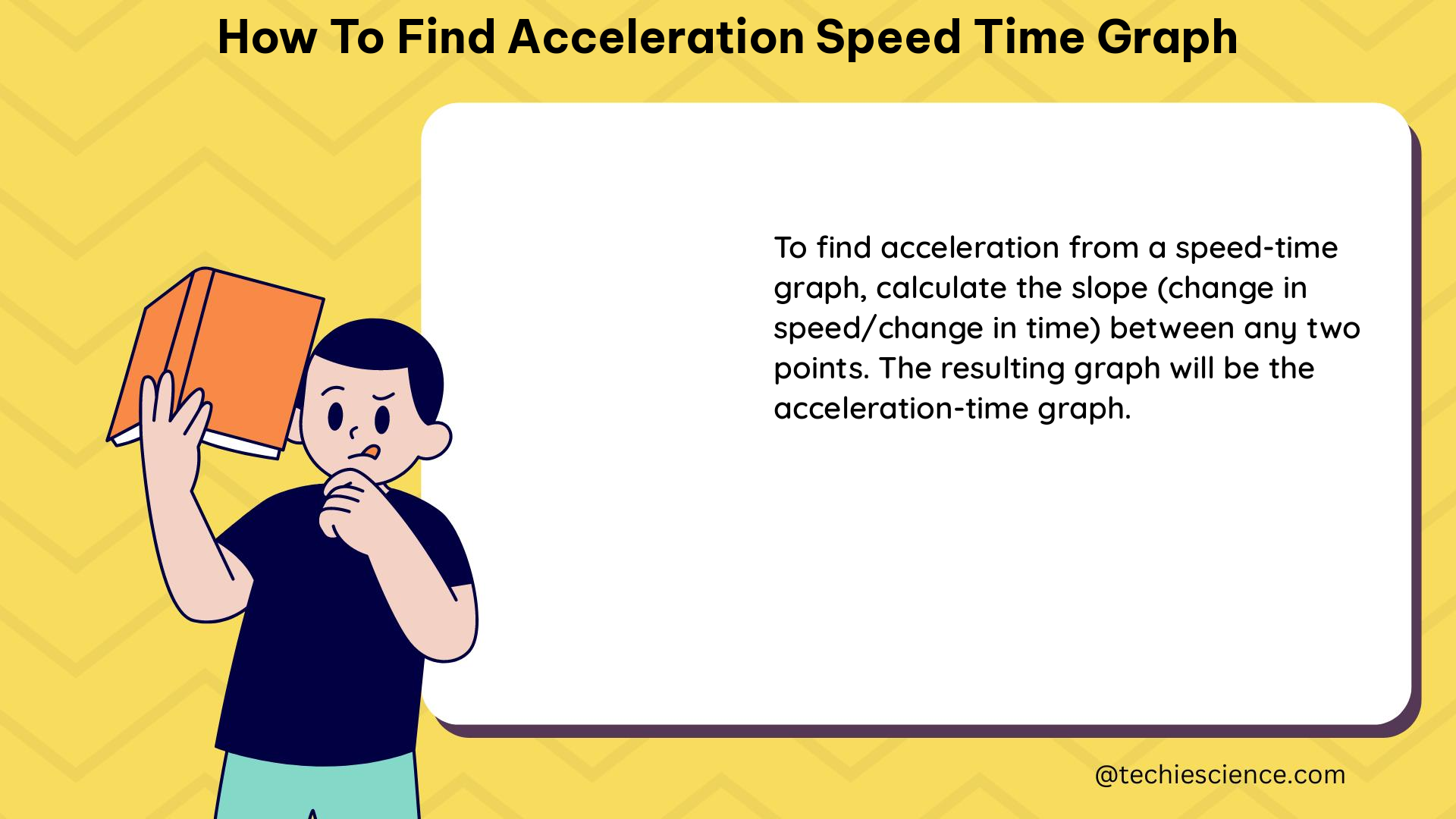Summary
Determining the acceleration-speed-time graph is a crucial skill in physics, as it allows us to understand the motion of an object and its underlying dynamics. This comprehensive guide will take you through the step-by-step process of constructing the acceleration-speed-time graph, starting from the fundamental relationships between position, velocity, and acceleration. We’ll explore various examples, from simple constant acceleration scenarios to more complex situations, and provide you with the necessary equations, formulas, and techniques to master this concept.
Understanding the Relationship between Position, Velocity, and Acceleration

The key to finding the acceleration-speed-time graph lies in understanding the relationship between position, velocity, and acceleration. Position (s) is the location of an object, velocity (v) is the rate of change of position, and acceleration (a) is the rate of change of velocity.
The mathematical relationships between these quantities are as follows:
- Velocity-Time Relationship:
v = ds/dt - Acceleration-Time Relationship:
a = dv/dt
These relationships form the foundation for constructing the acceleration-speed-time graph.
Constant Acceleration Example
Let’s consider a simple example of a car accelerating from rest to a speed of 60 mph in 10 seconds.
- Velocity-Time Graph: The velocity-time graph for this motion would be a straight line starting at the origin (0,0) and ending at (10,60).
- Acceleration Calculation: To find the acceleration, we can use the slope formula:
- Slope = (y2 – y1) / (x2 – x1)
- Slope = (60 – 0) / (10 – 0) = 6 mph/s
- Acceleration-Time Graph: The acceleration-time graph would be a horizontal line at 6 mph/s, indicating a constant acceleration.
Variable Acceleration Example
Now, let’s consider a more complex scenario where the acceleration is not constant. Suppose a car is moving in a straight line with a constant acceleration of 5 m/s^2.
- Position-Time Relationship: The position of the car at any time
tcan be calculated using the equation: s(t) = s0 + v0*t + 0.5*a*t^2- where
s0is the initial position,v0is the initial velocity, andais the acceleration. - Position-Time Graph: Assuming
s0 = 0,v0 = 0, anda = 5 m/s^2, we can calculate the position of the car at different times:
| Time (s) | Position (m) |
|---|---|
| 0 | 0 |
| 1 | 2.5 |
| 2 | 10 |
| 3 | 22.5 |
| 4 | 40 |
| 5 | 62.5 |
The position-time graph would be a parabola.
3. Velocity-Time Graph: The slope of the position-time graph at any point gives the velocity of the car at that time. We can find the slope by drawing a tangent line and calculating its slope.
* For example, at t = 1 s, the slope of the tangent line is (3 - 0.5) / (1 - 0) = 2.5 m/s.
* The velocity-time graph at t = 1 s would be a horizontal line at 2.5 m/s.
4. Acceleration-Time Graph: Once we have the velocity-time graph, we can find the acceleration-time graph by finding the slope of the velocity-time graph.
* The slope of the velocity-time graph at any point gives the acceleration of the car at that time.
* In this case, the acceleration-time graph would be a horizontal line at 5 m/s^2, indicating a constant acceleration.
Theorems and Formulas
- Kinematic Equations:
s(t) = s0 + v0*t + 0.5*a*t^2v(t) = v0 + a*t-
v^2 = v0^2 + 2*a*s -
Slope Formula:
Slope = (y2 - y1) / (x2 - x1)
Numerical Problems
- A car accelerates from rest to a speed of 80 km/h in 5 seconds. Find the acceleration-time graph.
Given:
* Initial velocity, v0 = 0 km/h
* Final velocity, v = 80 km/h
* Time, t = 5 s
Solution:
* Acceleration, a = (v - v0) / t = (80 - 0) / 5 = 16 km/h/s
* The acceleration-time graph would be a horizontal line at 16 km/h/s.
- A ball is thrown upward with an initial velocity of 20 m/s. Assuming a constant acceleration due to gravity of -9.8 m/s^2, find the acceleration-time graph.
Given:
* Initial velocity, v0 = 20 m/s
* Acceleration due to gravity, a = -9.8 m/s^2
Solution:
* The acceleration-time graph would be a horizontal line at -9.8 m/s^2, indicating a constant downward acceleration due to gravity.
Figures and Illustrations
-
Velocity-Time Graph for Constant Acceleration:

-
Position-Time Graph for Constant Acceleration:

-
Acceleration-Time Graph for Constant Acceleration:

-
Velocity-Time Graph for Variable Acceleration:

-
Acceleration-Time Graph for Variable Acceleration:

Conclusion
In this comprehensive guide, we have explored the fundamental concepts and techniques required to find the acceleration-speed-time graph. By understanding the relationships between position, velocity, and acceleration, and applying the relevant formulas and equations, you can now confidently construct the acceleration-speed-time graph for a variety of motion scenarios, from simple constant acceleration to more complex variable acceleration cases.
Remember, the key to mastering this skill is to practice solving different problems and continuously refine your understanding of the underlying principles. Good luck with your physics studies!
References
- Khan Academy, “What are acceleration vs. time graphs?”, https://www.khanacademy.org/science/physics/one-dimensional-motion/acceleration-tutorial/a/what-are-acceleration-vs-time-graphs
- Physics Classroom, “Acceleration”, https://www.physicsclassroom.com/class/1DKin/Lesson-4/Acceleration
- HyperPhysics, “Acceleration”, https://hyperphysics.phy-astr.gsu.edu/hbase/accel.html
- University of Arizona, “Acceleration”, https://www.physics.arizona.edu/~eric/courses/phy102/notes/acceleration.html

The lambdageeks.com Core SME Team is a group of experienced subject matter experts from diverse scientific and technical fields including Physics, Chemistry, Technology,Electronics & Electrical Engineering, Automotive, Mechanical Engineering. Our team collaborates to create high-quality, well-researched articles on a wide range of science and technology topics for the lambdageeks.com website.
All Our Senior SME are having more than 7 Years of experience in the respective fields . They are either Working Industry Professionals or assocaited With different Universities. Refer Our Authors Page to get to know About our Core SMEs.